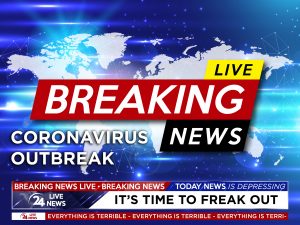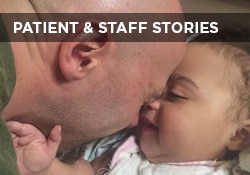This website uses cookies so that we can provide you with the best user experience possible. Cookie information is stored in your browser and performs functions such as recognising you when you return to our website and helping our team to understand which sections of the website you find most interesting and useful.

Susan E. Mazer, Ph.D. Blog
Thoughts and ideas on healthcare
Hi, and welcome to my blog! I'm Susan E. Mazer -- a knowledge expert and thought leader on how the environment of care impacts the patient experience. Topics I write about include safety, satisfaction, hospital noise, nursing, care at the bedside, and much more.
COVID-19: When Fear Is a Risk Factor and the News, a Pathogen
March 12, 2020
 Global, natural, and man-made disasters have become a painfully common occurrence. In the last two years, the world has faced hurricanes and earthquakes, mass shootings, terrorists driving trucks into crowds, and a recurrence of measles, whooping-cough, and tuberculosis. Now, we have COVID-19, a virus that remains unknown while it spreads throughout communities.
Global, natural, and man-made disasters have become a painfully common occurrence. In the last two years, the world has faced hurricanes and earthquakes, mass shootings, terrorists driving trucks into crowds, and a recurrence of measles, whooping-cough, and tuberculosis. Now, we have COVID-19, a virus that remains unknown while it spreads throughout communities.
What is new with COVID-19 is the growing panic that has come not from information, but from misinformation and rumor. Nonetheless, the pressure is on our clinical teams whose own health and families are as much or more at risk as those they are caring for.
Looking back to 9/11, the media frenzy showing the falling towers at least 5 times an hour was very distressing. It was so difficult to believe what happened right in front of us. However, as time went on, it became clear that the unending repetition of the tragic event on every news channel could cause further suffering.
Breaking the News
At that time, administrators at Craig Hospital, which cares for spinal cord and traumatic brain injury patients, quickly realized that the continuous televised broadcast of the collapse of the Twin Towers, which included footage of people jumping from burning buildings, was negatively affecting their patients. The ongoing exposure to heartbreaking footage was not healthy or healing for their patients. In order to combat the stress and anxiety created by the news channels, they decided to lock their televisions onto The C.A.R.E. Channel.
The bombing at the Boston Marathon, the 2015 attacks in Paris, the bombing of a Synagogue, the Charlottesville violence, more school shootings, and new threats to the US and other countries are now repeatedly reported events, over-shadowing all others.
Is this what your patients and families are watching? Do these news reports echo in the spaces of your waiting rooms? For hours on end?
Most of all, is this what is best for your patients? Does the continual broadcast of terrible and frightening news make your patients and families feel better? Does it improve their coping skills? Does hearing the most current numbers regarding cases of Coronavirus and the number of deaths, make them hopeful? Will this help them heal?
These are serious questions to address.
We can no longer escape from life beyond the hospital as the television brings the world, both good and bad, directly to the patient’s bedside. However, we can protect our patients and families from the ongoing assault of bad news.
A Critical Alternative to Broadcast Television
Since its inception, The C.A.R.E. Channel has provided a therapeutic and engaging alternative to commercial television. In 1992, when it was launched, we were not facing the kinds of ongoing existential threats that threaten us today. But, the needs of our patients were obvious, and the goal remains the same: As Nightingale said, to “put your patient in the best position for nature to act upon him.”
Clearly, hearing continual rants about pandemics, mass shootings, terrorist attacks, suicide bombs, and domestic violence are not helping your patients.
In addition, self-quarantine at home poses still other challenges regarding media exposure. We developed C.A.R.E. Connect to provide patients the opportunity to watch C.A.R.E. at home, either streamed on a computer or on a SMART TV.
How Can Your Hospital Combat Toxic TV?
Become more aware of commercial programming as you enter each patient’s room. Inform patients and families of the physical, emotional, and psychological impact bad news has on them, and on you. Show them The C.A.R.E. Channel and any other options they have to break the news cycle. Guidance from your nurses and others will certainly help them get respite from their own fears. Provide discharge plans that encourage continuing recovery at home to be done in an environment that reduces stress, minimizes anxiety, and offers positive distractions.
From Notes on Nursing, Florence Nightingale wrote:
“…To nurses I say – these are the visitors who do your patient harm.
When you hear him told:
1. That he has nothing the matter with him, and that he wants cheering.
2. That he is committing suicide, and that he wants preventing.
3. That he is the tool of somebody who makes use of him for a purpose.
4. That he will listen to nobody, but is obstinately bent upon his own way; and
5. That he ought to be called to a sense of duty, and is flying in the face of Providence; then know that your patient is receiving all the injury that he can receive from a visitor.
… How little the real sufferings of illness are known or understood. How little does any one in good health fancy him or even herself into the life of a sick person.
… Do, you who are about the sick or who visit the sick, try and give them pleasure, remember to tell them what will do so. How often in such visits the sick person has to do the whole conversation, exerting his own imagination and memory, while you would take the visitor, absorbed in his own anxieties, making no effort of memory or imagination, for the sick person.”
Let us all take care of each other, fully inform ourselves about what is real, and remove unfounded anxieties when they are fed through rumor, media, and any other misinformation source.
We are here to help you and your organization through this global crisis. Our mission remains the same and we want to help ensure that your patients and staff have C.A.R.E. Programming, when they need it most.
Call our toll free number today at 1-800-348-0799 or send an email to info@healinghealth.com










